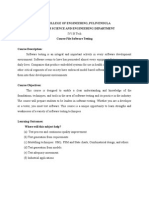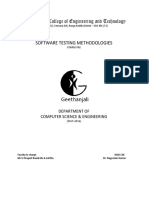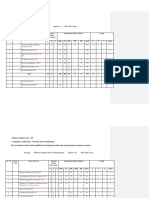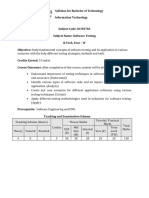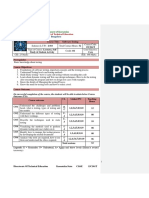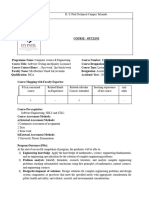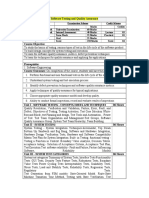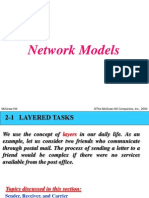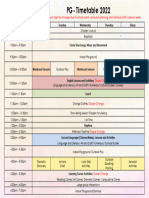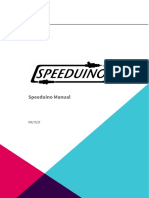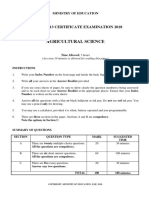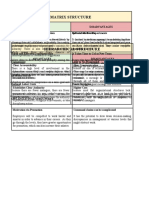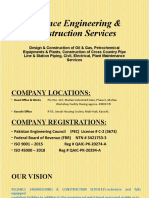1
Department of Computer Science and Engineering
Course Name
: Software Testing Methodologies
Course Number
: 57047
Course Designation
: Core
Prerequisites
: Software Engineering
IV B Tech I Semester
(2013-2014)
B. Ujwala
Assistant Professor
SYLLABUS
Unit I
Introduction: Purpose of testing, Dichotomies,
consequences of bugs, taxonomy of bugs.
Unit II
Flow graphs and Path testing : Basics concepts of path testing, predicates,
path predicates and achievable paths, path sensitizing, path instrumentation,
application of path testing
Unit
III
model
for
testing,
Transaction Flow Testing: Transaction flows, transaction flow testing
techniques.
Dataflow testing: Basics of dataflow testing, strategies in dataflow testing,
application of dataflow testing.
Unit IV
Domain Testing: Domains and paths, Nice & ugly domains, domain testing,
domains and interfaces testing, domain and interface testing, domains and
testability
Unit V
Paths, Path products and Regular expressions: Path products & path
expression, reduction procedure, applications, regular expressions & flow
anomaly detection.
Unit VI
Logic Based Testing: Overview, decision tables, path expressions, kv charts,
specifications
Unit
VII
State, State Graphs and Transition testing: State graphs, good & bad
state graphs, state testing, Testability tips.
UnitVIII
Matrices and Application: Motivational overview, matrix of graph, relations,
power of a matrix, node reduction algorithm, building tools
(student should be given exposure to tools like JMeter and Win runner tools)
TEXT BOOKS & OTHER REFERENCES
Text Books
1.
2.
Software Testing techniques - Boris Beizer, Dreamtech, second edition.
Software Testing Tools Dr.K.V.K.K.Prasad, Dreamtech
Suggested / Reference Books
3.
The craft of software testing - Brian Marwick, Pearson Education.
�3
4.
5.
6
7
Software Testing Techniques SPD (Oreille)
Software Testing in the Real World Edward Kit, Pearson.
Effective methods of Software Testing, Perry, John Wiley.
Art of Software Testing Meyers, John Wiley
Websites References
1. www.tutorialspoint.com/software_testing/software_testing_quick_guide.ht
m
2.
3.
www.etestinghub.com
https://www.owasp.org/index.php/Testing_Guide_Introduction
Time Table
Room No:
Time
MON
TUE
WED
THU
FRI
SAT
9:00
-09:50
09.50
10:40
10:40
11:30
11:30
12: 20
1:10
2:00
2:00
2:50
2:50
3:40
LUNCH BREAK 12:20 1:10
Class
Hour
W.E.F:
PROGRAM EDUCATIONAL OBJECTIVES (PEOs)
PEO1
The Graduates are employable as software professionals in reputed
industries.
PEO2
The Graduates analyze problems by applying the principles of
computer science, mathematics and scientific investigation to design
and implement industry accepted solutions using latest technologies.
PEO3
The Graduates work productively in supportive and leadership roles on
multidisciplinary teams with effective communication and team work
skills with high regard to legal and ethical responsibilities.
PEO4
The Graduates embrace lifelong learning to meet ever changing
developments in computer science and Engineering.
PROGRAM OUTCOMES (POs)
PO1
An ability to communicate effectively and work on multidisciplinary
teams.
PO2
An ability to identify, formulate and solve computer system problems
with professional and ethical responsibility.
PO3
A recognition of the need for, and an ability to engage in life-long
learning to use the latest techniques, skills and modern engineering
tools
PO4
The broad education necessary to understand the impact of
engineering solutions in a global, economic, environmental and social
context.
PO5
An ability to apply knowledge of mathematics, science, and computing
to analyze, design and implement solutions to the realistic problems.
PO6
An ability to apply suitable process with the understanding of software
development practice.
Course Outcomes:
1. Have an ability to apply software testing knowledge and engineering
methods.
2. Have an ability to design and conduct a software test process for a
software testing project.
3. Have an ability understand and identify various software testing
problems, and solve these problems by designing and selecting
software test models, criteria, strategies, and methods.
4. Have an ability to use various communication methods and skills to
communicate with their teammates to conduct their practice-oriented
software testing projects.
5. Have basic understanding and knowledge of contemporary issues in
software testing, such as component-based software testing problems
6. Have an ability to use software testing methods and modern software
testing tools for their testing projects.
MAPPING OF COURSE OUT COMES WITH
POs & PEOs
Course
Outcomes
POs
PEOs
CO1
CO2
CO3
CO4
CO5
CO6
PO
PO
PO
PO
PO
PO
PEO
PEO
PEO
PEO
PEO
PEO
COURSE SCHEDULE
Distribution of Hours Unit Wise
Chapters
Unit
Topic
Introduction
II
Flow graph & Path testing
III
Transaction flow testing &
Dataflow testing
IV
Domain Testing
Paths, path products &
Regular Expressions
VI
Logic based testing
VII
State, state graphs &
transition testing
VIII
Graph Metrics Applications
Book1
Book2
Ch1,2
Ch 3,4,5
Ch 6, 7
Ch 8
Ch 9,10,11
Ch 12
Ch13
Ch14
Contact classes for Syllabus coverage
Tutorial Classes : 05 ; Online Quiz : 1 per unit
Descriptive Tests : 02 (Before Mid Examination)
Revision classes :1 per unit
Total No.
of Hours
8
9
Ch 13
Ch 15
12
65
Number of Hours / lectures available in this Semester / Year
65
The number of topic in every unit is not the same because of the variation, all
the units have an unequal distribution of hours
Lecture Plan
S. No.
Topic
Unit-1
Introduction:
Purpose of testing
Dichotomies
Model for testing
Consequences of bugs
Night mare list of when to stop testing
Taxonomy of bugs
Unit-2
6
Flow graph & Path testing: Basic concepts of
Date of
Completion
�9
path testing
Predicates
Path predicates Achievable paths
Path sensitizing
10
Path instrumentation
11
Application of path testing
Unit-3
14
Transaction flow testing & Dataflow testing:
Basic concepts of Transaction flow testing
15
Transaction flows
16
Timing diagram
17
Transaction flow testing techniques
18
Basic concepts of Dataflow testing
19
Strategies in dataflow testing
20
Application of data flow testing
Unit-4
21
Domain Testing :Domains & paths
22
Nice & ugly domains
23
Domain testing
�10
24
Domains & interface testing
Unit-5
30
31
32
33
Paths, path products & Regular Expressions:
Path products path expressions
Reduction procedure
Applications
Regular expressions flow anomaly detection
Unit-6
39
Logic based testing: Overview of Logic based
testing
40
Decision tables
41
Path expressions
42
Kv charts
43
Sample problems on KV Charts
Unit-7
48
State, state graphs &
Introduction to State graphs
49
Good & bad state graphs
50
State testing
51
Testability tips
transition
Unit-8
testing:
�11
57
Graph Matrix Applications: Motivational overview
58
Matrix of graph
59
Relations
60
Power of matrix
61
Node reduction algorithm
62
Building tools
Date of Unit Completion & Remarks
Unit 1
Date
__ / __ / __
Remarks:
________________________________________________________________________
________________________________________________________________________
Unit 2
Date
__ / __ / __
Remarks:
________________________________________________________________________
________________________________________________________________________
Unit 3
Date
Remarks:
__ / __ / __
�12
________________________________________________________________________
________________________________________________________________________
Unit 4
Date
__ / __ / __
Remarks:
________________________________________________________________________
________________________________________________________________________
Unit 5
Date
__ / __ / __
Remarks:
________________________________________________________________________
________________________________________________________________________
Unit 6
Date
__ / __ / __
Remarks:
________________________________________________________________________
________________________________________________________________________
Unit 7
Date
__ / __ / __
Remarks:
________________________________________________________________________
________________________________________________________________________
Unit 8
__ / __ / __
�13
Remarks:
________________________________________________________________________
________________________________________________________________________
Unit Wise Assignments (With different Levels of thinking
(Blooms Taxonomy))
Note: For every question please mention the level of Blooms taxonomy
Unit 1
1.
2.
The purpose of testing is to show that software works give your
comments.
Specify on which factors importance of bugs depends and give metrics for
it.
�14
3.
Classify the different kinds of bugs.
4.
Differentiate i.Functional & Structural Testing ii. Debugging & Testing
Unit 2
1.
2.
Double link markers are more effective than single link markers justify
the statement
How a programs control structure can be represented graphically?
Explain with the help of required diagrams.
Consider the following flow - graph? Select optimal number of paths to
achieve C1+C2 (statement coverage + branch coverage).
3.
4.
Illustrate Traversal marker.
Unit 3
1.
Compare data flow and path flow testing strategies?
2.
Analyze and assess various data flow testing strategies.
3.
4.
Static analysis alone is not enough for data flow testing. Justify?
Distinguish Control Flow and Transaction flow
Unit 4
1.
Classify what can go wrong with boundaries, then define a test
strategy for each case in domain testing?
2.
State and Explain various restrictions at domain testing processes.
3.
4.
Unit 5
Illustrate two dimensional domain bugs.
Explain how one-dimensional domains are tested?
�15
Obtain the mean processing time of a program represented by the
following flow graph. Numbers in the brackets are the probabilities and
the other numbers are processing times.
1.
2.
Illustrate Node reduction Procedure.
3.
With an Example explain Huangs theorem.
Unit 6
1.
Whether the predicates are restricted to Binary Truth value or not?
Explain?
2.
How the Boolean expression can be used in test case design
Demonstrate by means of truth tables the validity of the following
theorems of Boolean algebra:
i.
Associative Laws
ii.
Demorgan's theorems for three variables
iii.
Distributive Law
iv.
Absorption Rule
Compare and Contrast kv charts and decision tables.
Unit 7
1.
2.
3.
4.
Compare and contrast on Good & Bad State Graphs
The behavior of a finite state machine is invariant under all encodings.
Justify?
Write testers comments about state graphs
What are the types of bugs that can cause state graphs?
�16
Unit 8
1.
How node reduction optimization can be done.
Illustrate Partitioning Algorithm
2.
3.
Where graph matrices can be applied?
Unit Wise Case Studies (With different Levels of thinking
(Blooms Taxonomy))
Note: For every Case Study please mention the level of Blooms taxonomy
Unit 1
Analyze the code thoroughly and mention what type of bugs it consist
of.
main() {
Record city;
lnode *list = NULL;
while (data_to_read()) {
Readin_data(&city);
insert(&city, &list);
1.
}
}
void insert(Record*& city, lnode*& list) {
lnode* ptr = new lnode;
ptr->next = list;
list = ptr;
prt->data = city;
}
Unit 2
1.
For the following code
int f1(int x, int y){
while (x != y){
if (x>y) then
x=x-y;
else y=y-x;
return x;
}
�17
[A] Draw Flaw graph for this program.
[B] Find out independent paths for above flow graph.
[C] Find out Code Complexity for the same program.
Unit 3
program Example()
var staffDiscount, totalPrice, finalPrice, discount, price
staffDiscount = 0.1
totalPrice = 0
input(price)
while(price != -1) do
totalPrice = totalPrice + price
input(price)
od
print("Total price: " + totalPrice)
if(totalPrice > 15.00) then
discount = (staffDiscount * totalPrice) + 0.50
else
discount = staffDiscount * totalPrice
fi
print("Discount: " + discount)
finalPrice = totalPrice - discount
print("Final price: " + finalPrice)
endprogram
1.
For the above pseudo code draw the data flow Model
Unit 4
1.
Analyze the given domains.
Unit 5
�18
1.
Apply node reduction procedure to the above graph to find path
expression from node 1 to node 2.
Unit 6
Construct Decision Table for the following:
1.
Company X sells commodities to wholesale and retail outlets. Wholesale
customers receive a two percent discount on all orders. The company also
encourages both wholesale and retail customers to pay cash on delivery by
offering a two percent discount for this method of payment. Another two
percent discount is given on orders of 50 or more units. Each column
represents a certain type of order.
Unit 7
1.
There are two buttons on the watch called the ModeButton and
the IncButton; pressing either of these generates an event, which may cause
a transition between two states. There are three states called Display, Set
Hours and Set Minutes. Display is the start state, indicated by the arrow
from the black dot. In theSet Hours state, event ModeButton causes a
transition to the Set Minutes state, whereas event IncButton causes the
action Increase Hours to occur (with no state change). Draw State Diagram.
Unit 8
1.
Represent the above graph as a matrix and find the path expression.
Unit Wise Important Questions (With different Levels of
thinking (Blooms Taxonomy))
Note: For every question please mention the level of Blooms taxonomy
�19
Unit 1
1.
Why is it impossible for a tester to find all the bugs in a system? Why
might it not be necessary for a program to be completely free of
defects before it is delivered to its customers?
2.
To what extent can testing be used to validate that the program is fit
for its purpose.
3.
State and explain various dichotomies in software testing?
4.
Confer about requirements, features and functionality bugs
Unit 2
1.
How Link Counters are useful in Path Instrumentation method.
2.
State and explain various path selection rules.
3.
4.
Illustrate different types of loops.
What is meant by Co - incidental Correctness give an example.
Unit 3
1.
How data flow testing can explore data - flow anomalies?
2.
Compare data flow and path flow testing strategies?
3.
4.
Illustrate Data flow testing.
Converse about static and dynamic program slicing.
Unit 4
1.
State and Explain various restrictions at domain testing processes
2.
With a neat diagram, explain the schematic representation of domain
testing.
3.
Explain various properties related to Ugly-domains.
4.
Discuss with example the equal - span range/Doman compatibility bugs
Unit 5
1.
Explain Regular Expressions and Flow Anomaly detection.
2.
What we can find using Regular expression.
�20
3.
Find the maximum path count for the graph?
Unit 6
1.
Illustrate the applications of decision tables.
2.
How is a decision table useful in testing. Explain with an example.
Flow graphs are abstract representations of programs. Justify?
Reduce the following functions using K-Maps
F(A,B,C,D) = P(4,5,6,7,8,12,13)+d(1,15)
Unit 7
1.
Explain with an example how to convert specification into state-graph.
Also discuss how contradictions can come out.
2.
Write the design guidelines for building finite state machine into code.
3.
What are the principles of state testing. Discuss advantages and
disadvantages
Unit 8
1.
2.
3.
How can a relation matrix be represented and what are the properties of
relations?
Explain cross-term reduction and node term reduction optimization.
How a loop can be identified in a matrix
�21
Unit Wise Multiple Choice Questions
Unit I:
1. Consequences of bugs range from mild to catastrophic
2. A programs environment is the hardware or software to run it
3. importance of bug depends on correction cost,installation
cost,consequences,frequency
4. syntax errors come under the category of coding bugs
5. Insufficient effort in QA results in High Rejection Ratio
6. Higher Rework results in Higher Net Costs
7. The main Purpose of Testing is to catch bugs
8. Contents: are pure bit pattern & bugs are due to misinterpretation or
corruption of it.
9. Structure: Size, shape & alignment of data object in memory. A
structure may have substructures
10. Attributes: Semantics associated with the contents (e.g. integer,
string, subroutine).
11.Testing cost in consumer good is as low as [ ]
A. 12% B. 2% C. 4% D. 9%
Unit II:
1. SQA stands for Software quality assurance
2. A control flow graph is programs control structure
3. Acceptance test in done to find programs ability
4. Syntax error detection is archytepal result of static analysis
5. Phase 0: says no difference between debugging & testing
6. Phase 3: says Test for Risk Reduction
7. Phase 2: says Software does not work
8. Execute all statements in the program at least once under the some
test. Is called as statement testing
9. Path testing (with mainly P1 & P2) catches ~65% of bugs
10.
A point in the program where control flow can merge (into a
node of the graph) is Junction
�22
11.
A program point at which the control flow can diverge
decision
12.
A Multi-way branch or decision iscase statement
Unit III:
1. The outcome of test is what we expect to happen
2. System test does test the components of system
3. The normal sequence with regard to narmal variable (killed-k,usedu,defined-d) uu
4. Transaction-flow represents a systems processing
5. TFG represents a behavioral (functional) model of the program
(system) used for functional testing by an independent system tester.
6. System is controlled by a scheduler
7. DFG Test the Von Neumann way
8. dd means harmless and suspicious
9. dk means probably a bug.
10.
du means normal
11.
kd means normal
Unit IV:
1. A domain basically is a set
2. In the context of domain span for domain and interfacing testing for
every input variable we need atleast compatible domain spans &
compatible closure
3. Three generic cases of complex domains are disconnected
pieces,holes and concavities
4. to confirm compatibility of callers range and called routines domain
span we need to test every input variable
5. Domain testing Verifies if the classification is correct
6. Domain testing model Structural Knowledge is not needed
�23
7. Predicate Specifies the Domain Boundary
8. Nice domain Boundaries are Linear
9. Ugly domain
10.
are Non-linear Boundaries
Ambiguities
Detected by Specification languages & tools
Unit V:
1. ABCD+BCD+CD+AB can be reduced to CD+AB
2. ABC+BCD+CDE+EFG is said to be in the form of sum of
products
3. Path segment are also called as sub paths
4. A heauristic methods of sensitizing paths checks for predicate
coverage in the order independent uncorrelated,correlated
dependent
5. Path expression algebraic representation of sets of paths in a flow
graph.
6. Flow graph is an abstract representation of a program.
7. X + X
= X
8. Cross term step Removes nodes one by one till theres one entry
& one exit node.
9. 1+ + 1 = 1*
10.
Xm Xn
=
=
1
Xm+n
Unit VI:
1. break points Method is usefull where hard to sensitize paths
begin.
2. The process of changing operating environment to support old
software is rehosting
3. hardware logic test design tools and methods use logic & Boolean
algebra
4.
Knowledge based systems and artificial intelligence systems use
high level logic languages
5. Condition stub Lists condition relevant to decision
�24
6. Rules Specify which actions are to be followed for a given set of
conditions
7. x + x' = 1
8. x (y z) = (x y) z
9. 0' = 1
Unit VII:
1. In context of data object state and usage c,p stand for caluculation
and predicate
2. Using x+y>=7 when x+y>=7 is an intended example of shift
boundary
3. A state graph and its associated state table
4. State graphs are not dependent on time or temporal behavior or
the program
5. State testing doesnt test the Temporal behavior
6. The total number of states is equal to the product of possibilities of
factors that make up the state
7. Bad state graphs contain states not reachable
8. For every state and every input there is exactly one transition
specified to exactly one, possibly the same, state.
9. A good state graph has at least two input symbols
10.
state graph is strongly connected
Unit VIII:
1. A matrix is a set of real or complex numbers
2. To perform addition or subtraction on matrices, the two matrices must
be of the same order
3. If the rows and columns of a matrix are interchanged, it is called as
transpose of a matrix
4. matrix is called a square matrix if its number of row equals to the
number of columns.
5. A null (zero) matrix, N, is a matrix with all elements equal to 0.
6. A unit matrix, I, is a square matrix with all elements in the leading
diagonal equal to 1 and all other elements equal to 0.
7. A relation between finite sets can be represented using a zero-one
matrix.
�25
8. A directed graph consists of a set V of vertices (or nodes) together
with a set E of ordered pairs of elements of V called edges (or arcs).
University Question Papers
III B.Tech I Semester Examinations, November 2010
SOFTWARE TESTING METHODOLOGIES
Time: 3 hours
Max Marks: 80
Answer any FIVE
Questions
All Questions carry equal
marks
�26
[16]
1. Explain the following:
(a) Domain Dimensionality
(b) Systematic Boundaries
(c) Linear Boundaries
(d) Co-incidental correctness.
2. Dene structured code. Explain lower path count Arithmetic with
an example. [16]
3. (a) Explain the process of achieving (C +C ) coverage.
1
(b) How do you convert a ow-chart into a ow graph.
[
8
+
8
]
4. (a) Dene du path and denition-clear path segment.
(b) Why All-du-Paths (ADUP) is the strongest data-ow testing
strategy?[6+10]
5. (a) Dene state . Explain about state table
(b) Discuss about software Implementation of state [8+8]
graph.
6. What is a decision table and how does it is useful in testing.
Explain it with help
7. (a) What are Test and test design bugs, explain with example
(b) The importance of a bug type is calculated by multiplying
the
expected costof the nightmare by the probability of the bug and
summing across all the nightmares. How?
8. What are graph matrices and their applications?
�27
III B.Tech I Semester Regular Examinations,Nov/Dec
2009
Software Testing Methodologies
Time: 3 hours
Max Marks: 80
Answer any FIVE
Questions
All Questions carry equal
marks
[
1. (a) What are the advantages of matrix
representations?
(b) Write about loops in matrix representation.
8
]
2. (a) Explain the construction of control ow graph.
(b) How does a nested loop can be tested?
[8+8]
3. Dene structured code. Explain lower path count Arithmetic with
an example.[16]
4. (a) Explain dierent Ugly domains.
(b) How programmers and testers treat Ugly Domains.
5. Draw a hard disk recovery a state graph with a state table.
6. What are the 6 classes of bugs in the taxonomy of bugs.
7. (a) Explain the procedure to construct a Data Flow Graph.
(b) Construct the Data ow graph for the following problem.
i. Given L, t, and d, solve for Z .
ii. cos( C) = cos(L) sin(t)
iii. tan(M)= cot(L) cos(t)
iv. tan(Z+F)= -sin(L) tant(t)
v. tan (F) = cos(M) tan(M+d)
8. What is decision table and how does it is useful in testing
�28
Tutorial Sheet
Unit-I
Topics Revised
Date:
Quick Test Topics
Date:
Case Study Discussed
Date:
Unit-II
Topics Revised
Date:
Quick Test Topics
Date:
Case Study Discussed
Date:
Unit-III
�29
Topics Revised
Date:
Quick Test Topics
Date:
Case Study Discussed
Date:
Topics Revised
Date:
Quick Test Topics
Date:
Case Study Discussed
Date:
Unit-IV
Unit-V
Topics Revised
Date:
�30
Quick Test Topics
Date:
Case Study Discussed
Date:
Unit-VI
Topics Revised
Quick Test Topics
Case Study Discussed
Unit-VII
Topics Revised
�31
Quick Test Topics
Case Study Discussed
Unit-VIII
Topics Revised
Quick Test Topics
Case Study Discussed
TOPICS BEYOND SYLLABUS
Unit 1
1.
2.
3.
4.
�32
Unit 2
1.
2.
3.
4.
Unit 3
1.
2.
3.
4.
Unit 4
1.
2.
3.
4.
Unit 5
1.
2.
3.
4.
Unit 6
1.
2.
3
4
�33
Unit 7
1.
2.
3.
4.
Unit 8
1.
2.
3.
4.
ASSESMENT OF LEARNING OBJECTIVES AND OUT COMES: DIRECT
Blooms Taxonomy:
LEVEL 1
REMEMBERING
LEVEL 2
UNDERSTANDIN
G
LEVEL 3
APPLYING
LEVEL 4
ANALYZING
LEVEL 5
EVALUATING
LEVEL 6
CREATING
Exhibit memory of previously learned
material by recalling facts, terms, basic
concepts, and answers
Demonstrate understanding of facts and
ideas by organizing, comparing,
translating, interpreting, giving
descriptions, and stating main ideas.
Solve problems to new situations by
applying acquired knowledge, facts,
techniques and rules in a different way
Examine and break information into
parts by identifying motives or causes.
Make inferences and find evidence to
support generalizations.
Present and defend opinions by making
judgments about information, validity of
ideas, or quality of work based on a set
of criteria.
Compile information together in a
different way by combining elements in
a new pattern or proposing alternative
solutions.
�34
S.No.
1
2
3
4
5
6
7
8
9
10
11
12
13
14
15
16
17
18
19
20
21
22
23
Hall
Ticket
Number
IIntern
al
Marks
Assignment
Marks
Remarks
&
Blooms
Taxonom
y
Assessme
nt
IIInternal
Marks
Assignme
nt
Marks
Remarks
&
Blooms
Taxonomy
Assessme
nt
Av
g.
Ma
rks
�35
24
25
26
27
28
29
30
31
32
33
34
35
36
37
38
39
40
41
42
43
44
45
46
47
48
49
50
51
52
53
54
55
56
57
58
59
60
LEVEL(Level 5:Excellent Level 4:Very Good Level
3:Good Level 2:Satisfactory Level 1:Poor)
Student speaks in phase with the given topic confidently using Audio-Visual aids. Vocabulary is
exceptional
Student speaking with proper planning, fair usage of Audio-Visual aids. Vocabulary is good
Student speaking without proper planning, fair usage of Audio-Visual aids. Vocabulary is not
good
Student speaks in phase but no synchronization among the talk and Visual Aids.
Criteria
Oral Communication
S.No
5
4
3
2
1
5
2
4
Student speaks vaguely not in phase with the given topic.
Proper structuring of the document with relevant subtitles, readability of document is high with
correct use of grammar. Work is genuine and not published anywhere else.
Information gathered is relevant to the given task. Sentences were framed properly with correct
use of grammar.
�Writing Skills
36
3
Information gathered is relevant to the given task. sentences were framed properly with
inappropriate use of grammar
Information is gathered without continuity of topic, sentences were not framed properly. Few
topics are copied from other documents
Content Knowledge
Student Participation
Technical and analytical Skills
Practical
Knowledge
Social and Ethical
Awareness
5
4
3
2
Information gathered was not relevant to the given task. Content is copied from other
documents
Student identifies most potential ethical or societal issues and provides solutions for them
discussing with peers
Student identifies most potential ethical or societal issues and provides partial solutions for
them discussing with peers
Student identifies the societal and ethical issues but tries to provide solutions for them
discussing with peers
Student identifies the societal and ethical issues but fails to provide any solutions discussing
with peers
Student makes no attempt in identifying the societal and ethical issues
Student uses appropriate methods, techniques to model and solve the problem accurately
4
.
3
Student uses appropriate methods, techniques to model and solve the problem partially.
Student tries to model the problem and fails to solve the problem
Student fails to model the problem and also fails to solve the problem
Listens carefully to the class and answer the questions confidently
Listens carefully to the class and tries to answer questions confidently.
Listens carefully to the lecture and attempts to answer the questions
Student listens to the class but doesnt attempts to answer the questions
Student neither listens to the class nor attempts to answer the questions
5
4
3
Student uses appropriate methods to model the problem but attempts to solve the problem
The program structure is well organized with appropriate use of technologies and methodology.
Code is easy to read and well documented. Student is able to implement the algorithm
producing accurate results
Program structure is well organized with appropriate use of technologies and methodology.
Code is easy to read and not properly documented. Student is able to implement the algorithm
providing accurate results.
Program structure is well organized with appropriate use of technologies and methodology.
Code is quite difficult to read and not properly documented. Student is able to implement the
algorithm providing accurate results.
Program structure is well organized with usage of appropriate technologies and methodology.
Code is difficult to read and not documented properly and not able to execute the program
Program structure is not well organized with mistakes in usage of appropriate technologies and
methodology. Code is difficult to read and student is not able to execute the program
Independently able to write programs for any given context to strengthen the concepts covered
in theory
Independently able to write programs to strengthen the concepts covered in theory
Independently able to write programs and able to strengthen the concepts learned in theory
Understanding of Engineering core
37
2
Not able to write programs but able to strengthen the concepts learned in theory.
Not able to write programs and not able to strengthen the concepts learned in theory
5
4
3
2
Student uses appropriate methods, techniques to model and solve the problem accurately in the
context of multidisciplinary projects
Student tries to model the problem and solve the problem in the context of multidisciplinary
projects
Student tries to model the problem and attempts to solve the problem in the context
of multidisciplinary projects.
Student tries to model the problem but fails to solve the problem in the context
of multidisciplinary projects.
Student fails to model the problem and also fails to solve the problem in the context
of multidisciplinary projects
ASSESMENT OF LEARNING OBJECTIVES AND OUT COMES: INDIRECT
Blooms Taxonomy:
LEVEL 1
REMEMBERING
LEVEL 2
UNDERSTANDIN
G
LEVEL 3
APPLYING
LEVEL 4
ANALYZING
LEVEL 5
EVALUATING
LEVEL 6
CREATING
Exhibit memory of previously learned
material by recalling facts, terms, basic
concepts, and answers
Demonstrate understanding of facts and
ideas by organizing, comparing,
translating, interpreting, giving
descriptions, and stating main ideas.
Solve problems to new situations by
applying acquired knowledge, facts,
techniques and rules in a different way
Examine and break information into
parts by identifying motives or causes.
Make inferences and find evidence to
support generalizations.
Present and defend opinions by making
judgments about information, validity of
ideas, or quality of work based on a set
of criteria.
Compile information together in a
different way by combining elements in
a new pattern or proposing alternative
�38
solutions.
CSP Rubric Name & Number:
S.No.
1
2
3
4
5
6
7
8
9
10
11
12
13
14
15
16
17
18
19
20
21
22
23
24
25
26
27
28
29
30
31
32
33
34
35
36
37
38
39
Hall Ticket
Number
Rubric
Assessment
Blooms
Taxonomy
Assessment
Remarks
�39
40
41
42
43
44
45
46
47
48
49
50
51
52
53
54
55
56
57
58
59
60
Remedial Classes:
Unit Number
Unit-I
Unit-II
Unit-III
Unit-IV
Unit-V
Unit-VI
Unit-VII
Unit-VIII
Date Conducted
Add-on Programmes:
1
2
3
4
Guest Lectures:
1.
2.
3.
Topics Revised
�40
4.
Unit Wise PPTs:
Unit Wise lecture Notes:







